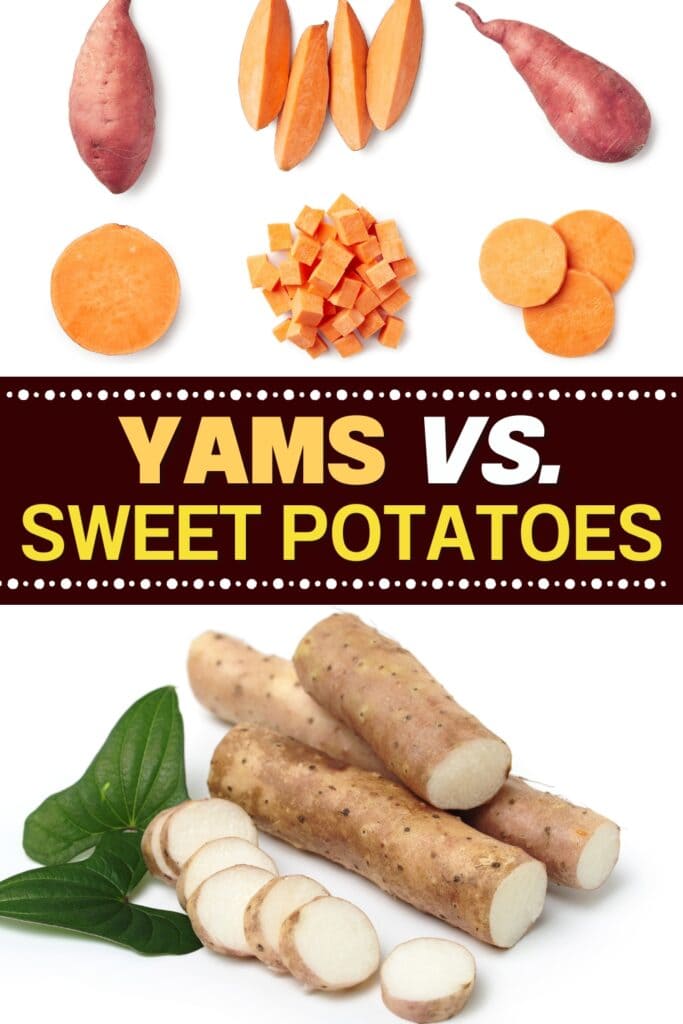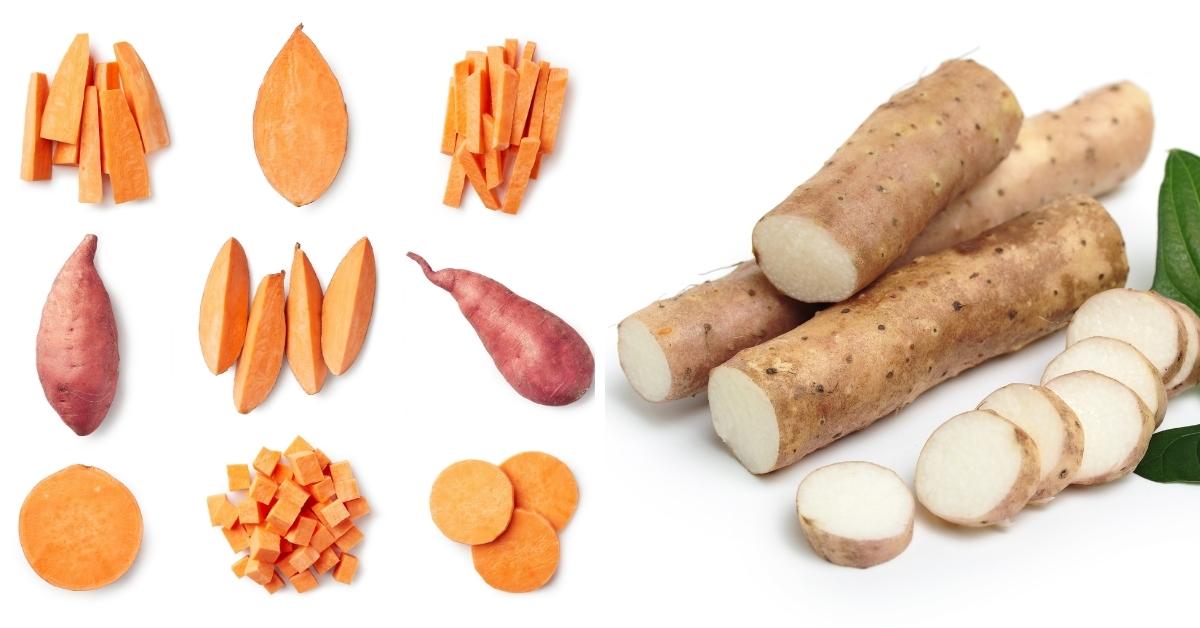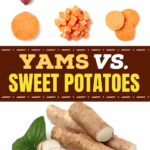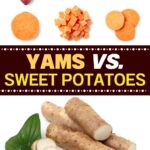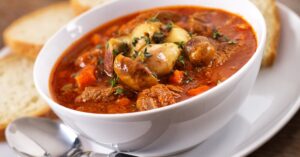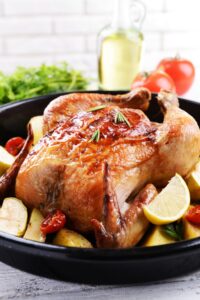If you live in the U.S., you’ve likely tried candied yams.
But if you look into yams vs. sweet potatoes, you’ll see that these tubers are pretty different.
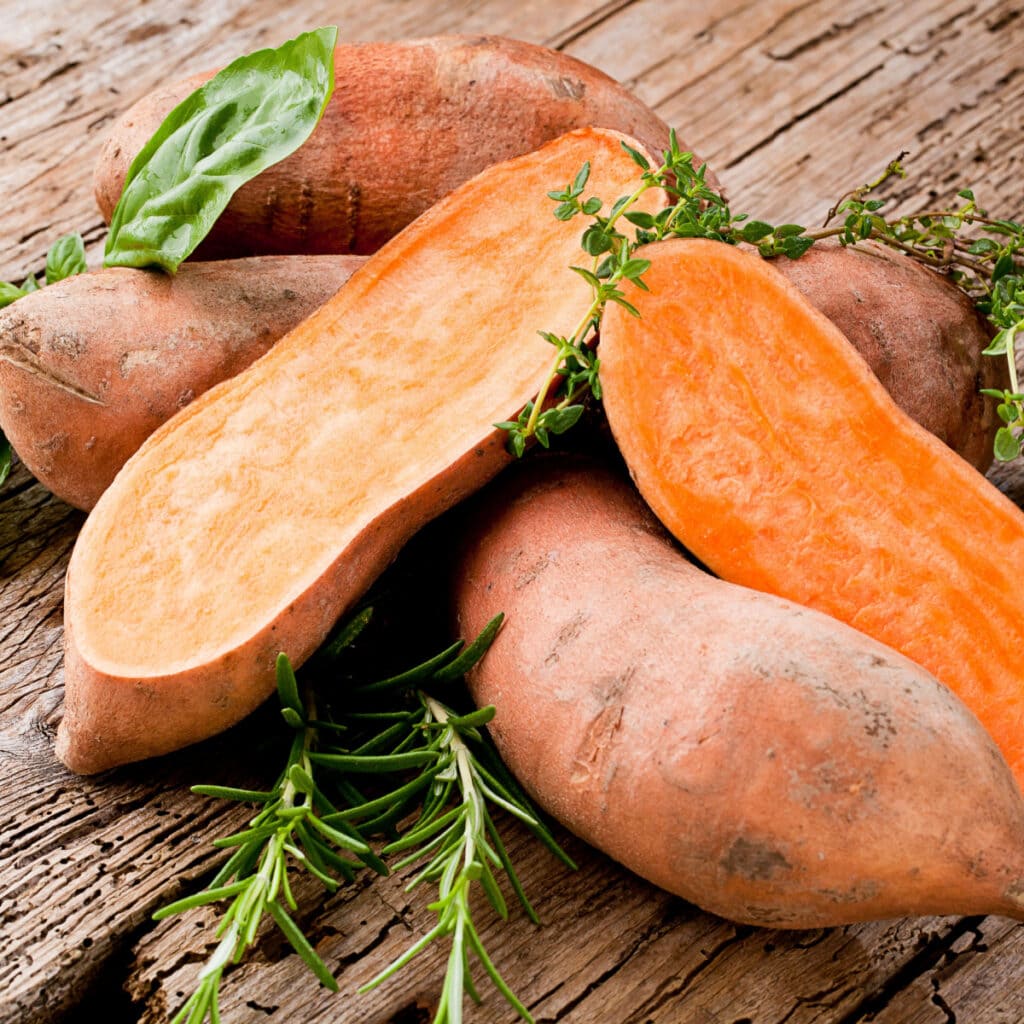
The whole yams vs. sweet potatoes debate debacle is kinda complicated.
And that’s because the word “yam” means something very different depending on where you are.
What we in the States call yams are actually sweet potatoes. And we typically use the words interchangeably.
But go to Japan, and you’ll see something very different – and purple!
So, yams vs. sweet potatoes…let’s get into it!
Are Yams and Sweet Potatoes the Same?
Short answer? No. But there’s a little bit more to it than that.
Yams and sweet potatoes are not the same thing, but they look similar.
They both have long, potato-shaped bodies and brownish skin. And they both have fairly hard flesh before cooking.
However, yams are usually rough on the surface with lighter flesh than the typical orange flesh of sweet potatoes.
That said, you’d be forgiven for thinking they’re the same because, in the U.S., they kind of are.
Origins
Back in the 19030s, Louisiana sweet potato farmers rebranded their new, softer strain as yams in order to stand out.
That’s why you’ll often see cans of “yams” with the words “sweet potato” right underneath. By law, they have to include the distinction.
But really, yams and sweet potatoes come from entirely different continents and plant families.
So they’re not at all related, botanically, and they taste nothing alike.
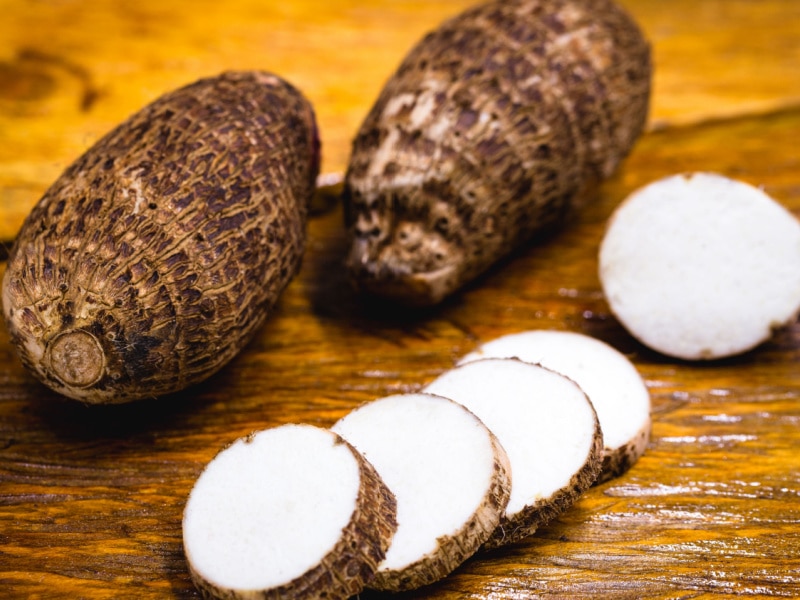
What Are Yams?
Yams are tubers from Africa and parts of Asia. They’re technically the edible root of the tropical vine Dioscorea Batatas.
Yams can now be found throughout the Caribbean and Latin America, and there are over 600 varieties. But the majority come from Africa.
Yams come in all shapes, sizes, and colors. However, the most common feature thick, bumpy, brown skin and white flesh.
(But as mentioned before, they can also be purple – ube is technically a yam!)
Here are some more fun yam facts:
- Yams are very nutritious. They boast a load of nutrients such as B6, manganese, and potassium.
- They’re a staple food in many tropical regions. This is because they have a very dry and starchy texture, which protects them from spoiling in humid climates.
- Yams are not sweet potatoes, nor are they regular potatoes. They are kind of in their own little plant bubble. But they taste more like regular potatoes or yucca than sweet potatoes.
- They have an earthy and neutral flavor. But they soak up other flavors very well.
- Yams can be prepared in many ways. You’ll frequently see them boiled, fried, or roasted and served with meat.
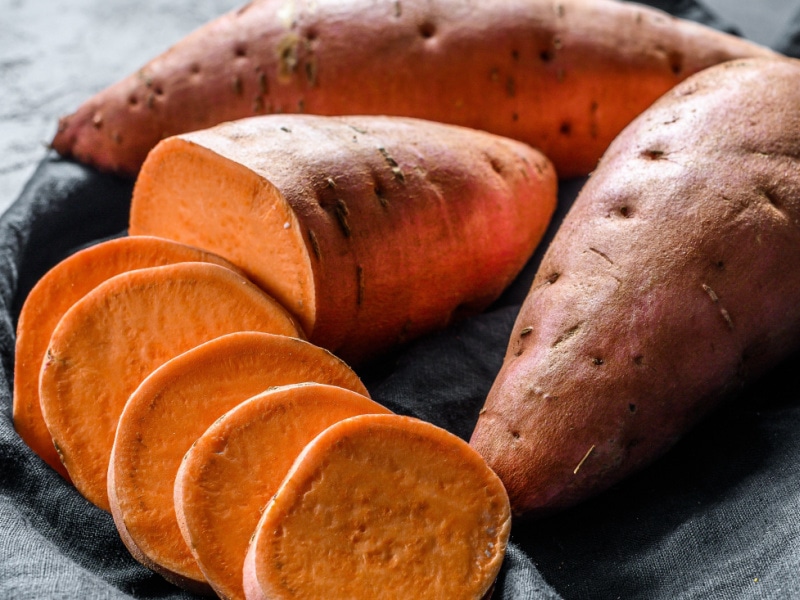
What Are Sweet Potatoes?
Sweet potatoes are tuber vegetables that come in three main varieties: orange, white, and purple.
Orange sweet potatoes are the most common and are often called yams. Sweet potatoes are native to Central and South America.
But one of the largest producers today is actually North Carolina.
Their scientific name is Ipomoea batatas, and they are part of the Convolvulaceae family.
You’ll find orange sweet potatoes pretty much everywhere. And you’ll see them featured on many a restaurant’s menus.
Orange Sweet Potatoes
As the name suggests, these have orange flesh with smooth, reddish-brown skin.
They’re typically oval-shaped with tapered ends. But you’ll see them long and skinny as well as chubby and round.
They have a sweet taste and soft texture and can be baked, boiled, or roasted.
White Sweet Potatoes
This variety usually has reddish-purple skin with white flesh.
They’re known as firm sweet potatoes because they don’t get nearly as soft. And they were the predominant sweet potato until the 1930s.
White sweet potatoes are more like regular potatoes in terms of taste and texture.
Purple Sweet Potatoes
Not to be confused with uba, purple sweet potatoes have red skin and either white or purple flesh.
They’re really delicious and are full of antioxidants.
There are two main varieties of purple sweet potato: one from North Carolina and the Okinawan sweet potato.
Though they’re hugely popular in Hawaii too!
Both can be used in desserts and savory dishes, and both are loaded with nutrients.
Why Do Yams and Sweet Potatoes Get Mixed Up?
Yams and sweet potatoes get mixed up primarily because of marketing.
A sweet potato farmer in the early 1900s chose to market a new variety of sweet potatoes as yams in order to set them apart. And the confusion has remained to this day.
For generations, sweet potatoes of the Americas were small, firm, and white or yellow-fleshed. A lot like African yams.
So, during slavery, many enslaved Africans referred to sweet potatoes as yams because it was the closest they had to the root vegetable of their home cuisine.
Then, in the 1930s, a new, softer, orange-fleshed sweet potato was introduced. And as I mentioned before, the growers wanted to differentiate their crops.
Since sweet potatoes had been unofficially called yams for decades, the growers went with it.
That said, don’t feel bad for being bamboozled. The United States is not the only country with some yam confusion.
In New Zealand and Malaysia, their “yams” aren’t actually yams, either.
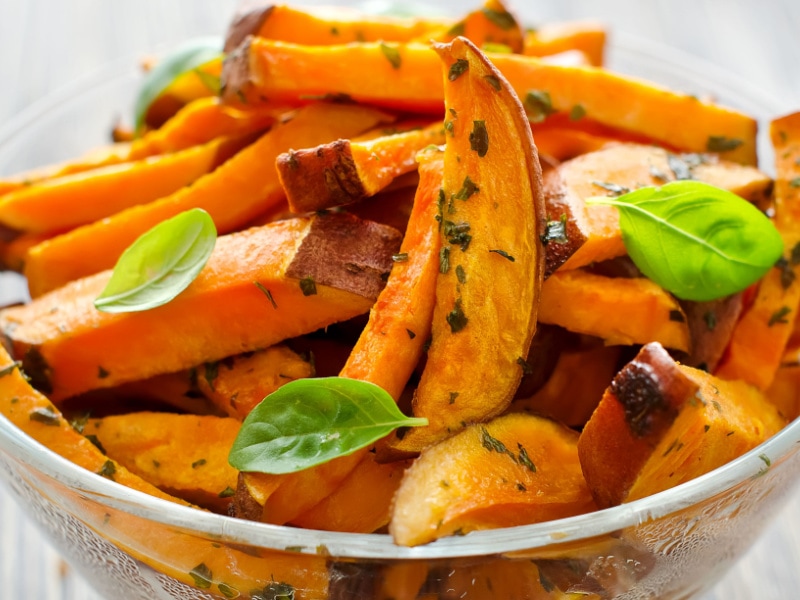
The Difference Between Sweet Potatoes and Yams
Is it making more sense now? Essentially we’ve all been referring to yams wrong this whole time, thanks to a century-old marketing campaign.
Pretty bizarre, right?
Luckily, we can easily cut through the confusion by looking at the differences between sweet potatoes and real yams.
Appearance
Yams
Yams have dark brown, sometimes black skin that’s very rough and bumpy and can even resemble tree bark.
They can develop “eyes” like regular potatoes, too.
Inside, the flesh is typically white. But it can be purple or red, depending on the type of yam.
Size-wise, they can be as small as potatoes or grow up to 5 feet long and weigh 150 pounds.
Sweet Potatoes
Sweet potatoes have thin, reddish-brown skin that’s relatively smooth. Though they may have rough patches.
Sweet potatoes do not develop “eyes” like regular potatoes, though.
Inside, the flesh is most commonly bright orange. But there are purple and white varieties as well.
Sweet potatoes can vary in size from long and thin to chunky and bulbous.
The heaviest sweet potato on record weighed in at 82 pounds.
Taste and Texture
Yams
Yams have an earthy and neutral flavor with very dry and starchy flesh.
They soften as they cook but are still quite starchy.
Sweet Potatoes
Sweet potatoes have a sweet flavor and softer, moister flesh than the average yam or potato.
They are soft when cooked, except the white ones.
Nutrition
Yams
Yams contain vitamins C and B6, protein, fiber, and beta-carotene. Plus, they’re incredibly high in Potassium.
They also have more calories than sweet potatoes and more carbohydrates.
Sweet Potatoes
Sweet potatoes contain vitamins C and B6, potassium, protein, and fiber. And per gram, they contain more of these nutrients than yams.
Plus, they’re rich in beta-carotene and lower in both carbs and calories than yams.
Availability
Yams
Yams are only available in specialty stores and online.
Sweet Potatoes
Sweet potatoes are widely available throughout stores in the United States. You can get them fresh, canned, and frozen in most stores.
They are often called yams, but the packaging should also say “sweet potato”.
Origin
Yams
Yams originated in Africa and parts of Asia.
They’re part of the Dioscoreaceae tropical plant family and are more closely related to lilies than potatoes.
Sweet Potatoes
Sweet Potatoes originated in Central and South America.
They’re part of the Convolvulaceae plant family and are related to morning glories.
Sweet Potato Recipes You’ll Love
Sweet Potato Pecan Pie
Easy Sweet Potato Soup
Paula Deen Sweet Potato Casserole
Whipped Sweet Potatoes
